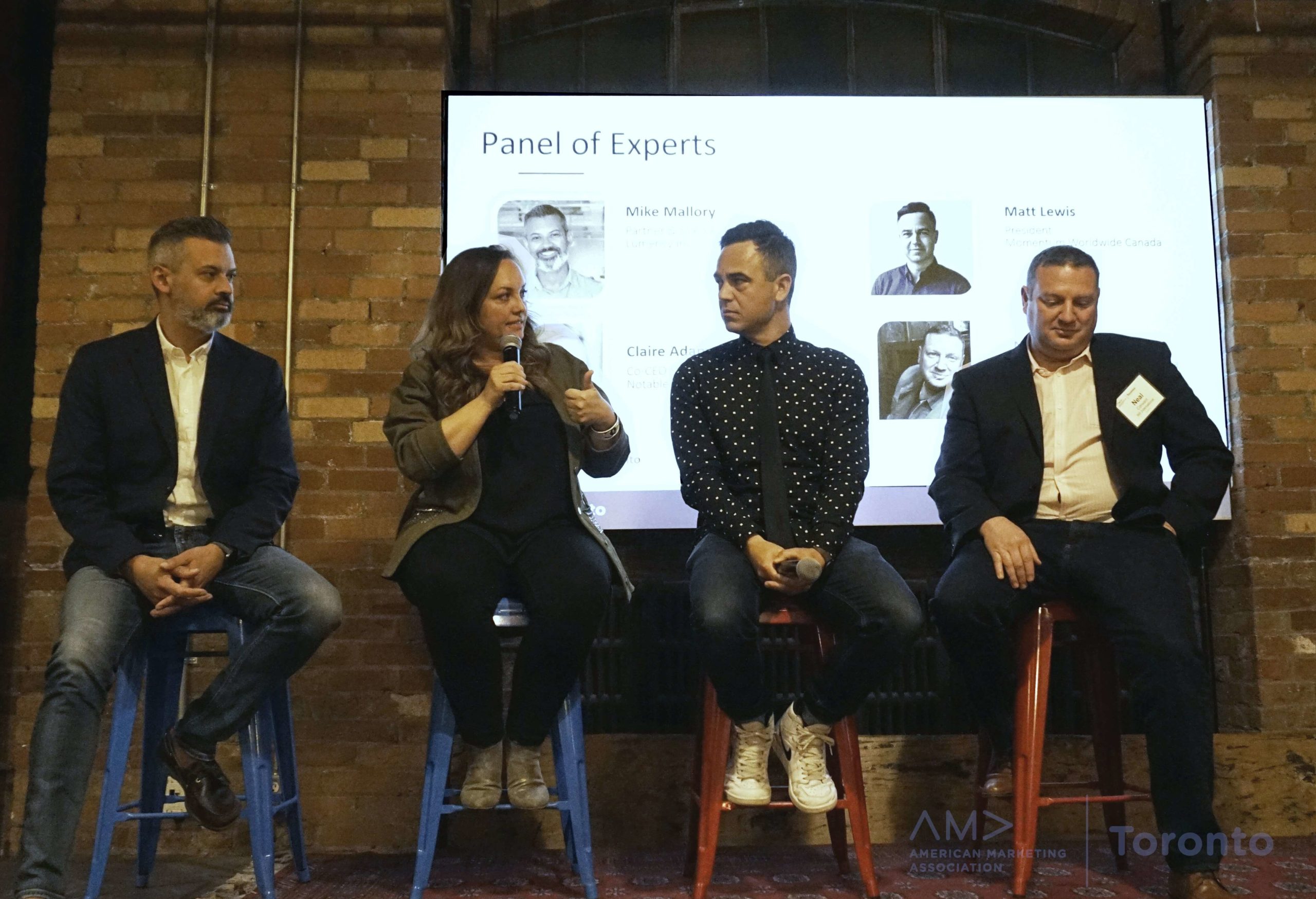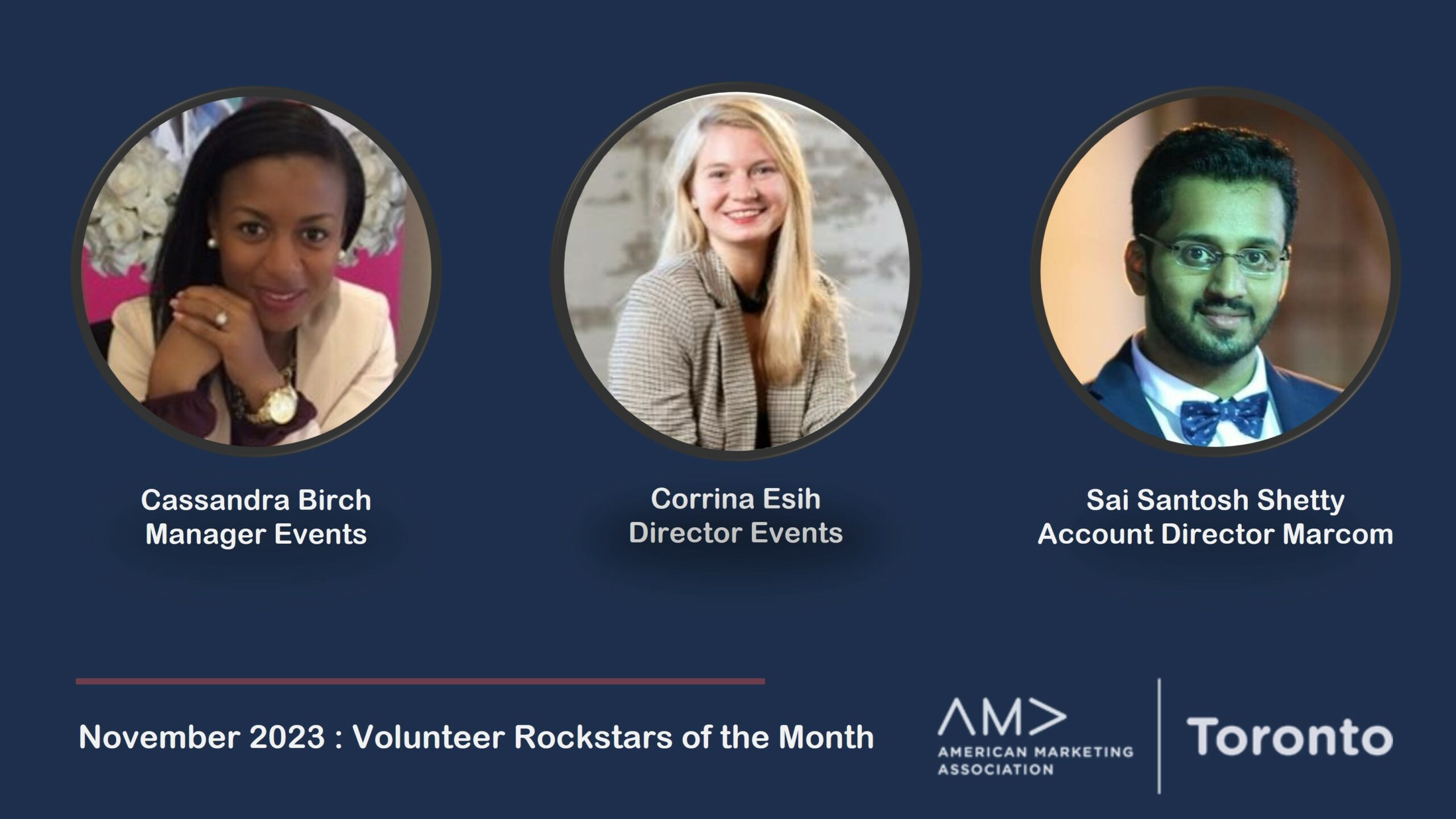After the original meeting scheduled for February 12, 2019 was postponed due to a winter storm in Toronto, marketers were excited to gather at Little Italy’s Revival Bar a week later for the much-anticipated panel discussion on Behavioural Marketing.
About the Panelists (from left to right in photo):
The panel mo derator, Melaina Vinski, Senior Director, Behavioural Insights at PWC, allowed the audience to learn more about this new marketing discipline.
derator, Melaina Vinski, Senior Director, Behavioural Insights at PWC, allowed the audience to learn more about this new marketing discipline.
Raj Sandhu has a PhD in Neuropsychology, and Vice President, Behavioural Science Insights and Strategy at Fresh Squeezed Ideas. For Raj, a key issue is “how we should use behavioural economics to help us move from insights to strategy to execution.”
Steffi Necheva (@SNecheva) has a background in educational psychology and behavioral economics, and has been at Sun Life as Director, Client Experience & Insights for two years. She is particularly interested in “how behavioural economics can be engaged in the design of smart solutions.”
Ada Le has a PhD in Cognitive Neuroscience, and is a Senior Associate at BEworks (@BeWorksInc). Ada is passionate about behavioural economics “because it is incredibly gratifying to help clients learn, particularly about the scientific method and how strategy and experiments can be used to best effect.”
After the introductions, the panel got right down to an engaging discussion of behavioural economics and how it is used in marketing.
Why aren’t you an organ donor? Behavioural economics has the answer
Lots of Canadians declare that they’re interested in organ donation, but they don’t follow through. Why are organ donation rates so low? As it turns out, in Canada, it’s because of the form. Here, we must choose to opt in: the default is opting out. In other countries, the default is opting in, and people must consciously decide not to donate.
Ada Le explained that behavioural economics “looks at how people perceive and behave in the face of making decisions,” and it incorporates analysis of how people actually do behave, rather than relying on theories about optimal behaviour.
Ada stated that behavioural economics “maps out the biases and looks at the barriers that are in place in how people act. If people have biases, what interventions—or nudges—can leverage these biases to get people to act in a certain way?”
Choices aren’t always rational
Steffi Necheva said that “marketing is a key driver of business growth.” As such, it seeks to understand customers and use that understanding to deliver highly engaging interactions to delight them. The traditional assumption is that consumers will make rational decisions. Of course, “if this actually happened,” said Steffi, “everyone would be in an ideal financial situation, with excellent preparations for retirement and minimal debt.”
Steffi focused on retirement planning. Over the last two decades, with the transition from defined benefit plans to defined contribution plans, consumers have had to make their own decisions about where to invest their retirement funds. But as Steffi stated, behavioural economic theory tells us “when there are more options, there’s less chance of action.” To counter this, financial planners do the legwork and offer a range of portfolios to their clients. “Behavioural economics,” said Steffi, “provides opportunities to marketers to reset the marketing discipline in an innovative way.”
Explaining how we choose
Raj Sandhu said that “traditional marketing looks to change hearts and minds, but behavioural economics looks at the impact behind decisions more directly. It looks at what a person needs to do in order to make a decision. Behavioural economics can be used to make it easier for the end user to decide.”
Ada Le stated that “people have preferences, but things get in the way. Choice architecture helps to reduce choice overload.” To explain further, Ada discussed infomercial phone lines, which are often so busy that potential buyers give up. A simple change in the message—adding a request to please hold, or please call back later—can have a dramatic impact on the number of completed transactions. Ada highlighted this as an “example of how behavioural economics can be very powerful in marketing.”
Behavioural economics in action
Raj Sandhu’s favourite example of behavioural economics in action are the Nespresso commercials featuring George Clooney and Danny DeVito. She said that they “show the influence of behavioural economics at two levels. First, as a brand, they make people want to buy the product. Coffee makes people feel sophisticated. Second, George Clooney is never at home, always shown in an upscale setting, such as an uber-fancy French café. This makes an implicit comparison between the quality of Nespresso coffee and the coffee you’d get in a French café.”
Steffi Necheva likes the example of robo advisors, such as WealthSimple, which feature pre-selected options put together by financial advisory teams. As Steffi said, “this takes away emotion. They offer well-balanced portfolios that are well-matched to specific risk profiles. With no emotional attachments to specific investments, pre-selected options offer a cost-efficient way of achieving one’s financial goals.”
Ada Le used the insurance company Lemonade to illustrate operational transparency, “a relatively new nudge that looks at what happens when you highlight the effort that was put in to a specific product or service.” Lemonade is completely transparent about everything they do, and it’s now beginning to take on a disruptive role in the industry.
Integrating science and marketing
Ada Le stated that while traditional marketing has done a lot to understand the customer, “behavioural economics adds the testing piece to the equation. It uses scientifically-designed experiments to test different solutions, testing them against each other, as well as against a control.”
Steffi Necheva said that “behavioural economics adds a scientific approach to marketing. It lets you find the right solution based on science. Marketing has always known the importance of emotion in the decision-making process. The scientific approach adds a degree of selectivity to marketing approaches – it lets the most successful tactics be implemented.”
Raj Sandhu said, “thinking about randomized trials at various field experiments, sometimes field experiments don’t work, then you’d perform random control testing in the lab. How do we create unified and integrated experiences that leverage behavioural economics? We merge behavioural economics with a design team for a more integrated approach. We create holistic experiences.”
Key ideas from the panel
Ada Le described social proof as her “most contentious” behavioural economics principle. As she stated, “Social proof explains why, in the face of uncertainty, people follow the crowd. It’s why marketing like ‘#1 toothpaste recommended by dentists’ works.”
Steffi Necheva’s favourite principle is group behaviour or herd behaviour: “people read about behavioural economics biases and principles, and they believe they’ll act more rationally as a result.” To illustrate her point, she described how Isaac Newton lost a fortune in the South Sea Bubble. “Even extreme intelligence can’t negate these biases!”
Raj Sandhu’s favourite principle is cognitive dissonance, “which means that we act in a manner that contradicts a belief that we hold. How do we manage this and deal with it? It’s hard to be perfect in everyday life, and we all have many ways of convincing ourselves that we’re acting in our best interests. We are masters at justifying our choices and actions to ourselves.”
Melaina Vinsky rounded out the discussion by pointing out that behavioural economics can also be used to nudge people against their own intentions: rather than a nudge, this is known as a “sludge.” She also said that there are sludge detectives: “people who look for retailers who exploit behavioural economics to the disadvantage of customers.”
The evening concluded with several interesting audience questions that delved further into the ways that behavioural economics can be used in marketing. In the end, all who were present came away with an increased understanding of how the science of behavioural economics is transforming the art of marketing. We’ll never look at commercials the same way again!This article was brought to you through the partnership between the AMA-Toronto and HeadStart Copywriting.




